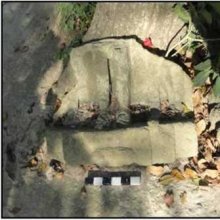Dharmanatha, Dharmanātha, Dharma-natha: 9 definitions
Introduction:
Dharmanatha means something in Jainism, Prakrit, Hinduism, Sanskrit. If you want to know the exact meaning, history, etymology or English translation of this term then check out the descriptions on this page. Add your comment or reference to a book if you want to contribute to this summary article.
Images (photo gallery)
In Jainism
General definition (in Jainism)
Source: Wisdom Library: JainismDharmanātha (धर्मनाथ) is another name for Dharma, the fifteenth Tīrthaṅkara (Janism recognizes 24 such teachers or Siddhas). His colour is red (rakta), according to Aparājitapṛcchā (221.5-7). His height is 45 dhanuṣa (a single dhanuṣa (or, ‘bow’) equals 6 ft), thus, roughly corresponding to 82 meters. His emblem, or symbol, is a Vajra.
Dharmanātha’s father is Bhānu and his mother is Suvratā. It is an ancient Jain practice to worship the Tīrthaṅkara’s parents in various rites, such as the pratiṣṭhāvidhi, according to the Ācāradinakara (14th century work on Jain conduct written by Vardhamāna Sūri).
Source: archive.org: The Jaina IconographyDharmanātha (धर्मनाथ) refers to the fifteenth of twenty-four Tīrthaṃkaras or Jinas, commonly depicted in Jaina iconography.—The symbol by which an image of Dharmanātha is to be recognised is Vajradaṇḍa or thunder-bolt. The Yakṣa couple to attend upon him are respectively called Kinnara and Kandarpā (Digambara Mānasī). The position of a lanner has been taken up by Puṇḍarīka-Vāsudeva. The Kevala tree for him is called Dadhiparṇa or Saptacchada.
With regard to his family we are told that his father’s name was Bhānu Rāja and his mother’s name Suvratā. He was born at Ratnapura. He obtained the name of Dharmanātha because he saved mankind from miseries. There is tradition also that the Jina’s mother performed many acts of religion while bearing him in the womb. Hence the name of the child as Dharmanātha. It appears that the symbol of the Tīrthaṃkara, as the name suggests, has evident connection with Yama’s staff. God Yama has another name of Dharmanātha or Dharmarāja. Hence, the similarity of symbolism.
Source: archive.org: TrisastisalakapurusacaritraDharmanātha (धर्मनाथ) or Dharma refers to the fifteenth of the twenty-four Tīrthaṅkaras praised in the first book (ādīśvara-caritra) [chapter 1] of Hemacandra’s 11th century Triṣaṣṭiśalākāpuruṣacaritra: an ancient Sanskrit epic poem narrating the history and legends of sixty-three illustrious persons in Jainism.
Accordingly, “[...] we worship the Arhats, who at all times and all places purify the people of the three worlds by their name, representation, substance, and actual existence. [...] We worship Dharmanātha, the teacher of fourfold dharma, like a kalpa-tree for attainment of creatures’ desires”.
Source: academia.edu: Tessitori Collection IDharmanātha (धर्मनाथ) or Dharmmanātha-gīta refers to one of the twenty-four songs (gīta) embedded in the Caturviṃśatijinagīta by Jinarāja (dealing with classical hymns and stotras from Jain literature), which is included in the collection of manuscripts at the ‘Vincenzo Joppi’ library, collected by Luigi Pio Tessitori during his visit to Rajasthan between 1914 and 1919.

Jainism is an Indian religion of Dharma whose doctrine revolves around harmlessness (ahimsa) towards every living being. The two major branches (Digambara and Svetambara) of Jainism stimulate self-control (or, shramana, ‘self-reliance’) and spiritual development through a path of peace for the soul to progess to the ultimate goal.
Languages of India and abroad
Sanskrit dictionary
Source: DDSA: The practical Sanskrit-English dictionaryDharmanātha (धर्मनाथ).—a legal protector, rightful master.
Derivable forms: dharmanāthaḥ (धर्मनाथः).
Dharmanātha is a Sanskrit compound consisting of the terms dharma and nātha (नाथ).
Source: Cologne Digital Sanskrit Dictionaries: Benfey Sanskrit-English DictionaryDharmanātha (धर्मनाथ).—m. a legitimate lord, [Rāmāyaṇa] 5, 33, 39.
Dharmanātha is a Sanskrit compound consisting of the terms dharma and nātha (नाथ).
Source: Cologne Digital Sanskrit Dictionaries: Monier-Williams Sanskrit-English DictionaryDharmanātha (धर्मनाथ):—[=dharma-nātha] [from dharma > dhara] m. legal protector, [Rāmāyaṇa]
[Sanskrit to German]
Sanskrit, also spelled संस्कृतम् (saṃskṛtam), is an ancient language of India commonly seen as the grandmother of the Indo-European language family (even English!). Closely allied with Prakrit and Pali, Sanskrit is more exhaustive in both grammar and terms and has the most extensive collection of literature in the world, greatly surpassing its sister-languages Greek and Latin.
See also (Relevant definitions)
Partial matches: Natha, Dharma, Tarma.
Starts with: Dharmanathagita.
Full-text (+22): Bhanu, Suvrata, Kinnara, Kandarpa, Bhanuraja, Ratnapura, Samsara, Ratnavaha, Dharma, Pundarika, Kashaya, Yoga, Shraddhana, Jnana, Samyakshraddha, Krodha, Antosha, Mana, Dharmasimha, Lobha.
Relevant text
Search found 7 books and stories containing Dharmanatha, Dharmanātha, Dharma-natha, Dharma-nātha; (plurals include: Dharmanathas, Dharmanāthas, nathas, nāthas). You can also click to the full overview containing English textual excerpts. Below are direct links for the most relevant articles:
Jain Remains of Ancient Bengal (by Shubha Majumder)
Images of Tīrthaṅkara Dharmanātha < [Chapter 6 - Iconographic Study of Jaina Sculptural Remains]
The twenty-four Tīrthaṅkaras and their Yakṣas and Yakṣiṇīs < [Chapter 6 - Iconographic Study of Jaina Sculptural Remains]
Meaning of Tīrthaṅkara < [Chapter 1 - Introduction and Scope of the Present Study]
Trishashti Shalaka Purusha Caritra (by Helen M. Johnson)
Part 23: Dharmanātha’s mokṣa (emancipation) < [Chapter V - Śrī Dharmanāthacaritra]
Part 19: Dharmanātha’s śāsanadevatās (messenger-deities) < [Chapter V - Śrī Dharmanāthacaritra]
Part 20: Dharmanātha’s samavasaraṇa < [Chapter V - Śrī Dharmanāthacaritra]
A study of the philosophy of Jainism (by Deepa Baruah)
Chapter I.c - The lives of the Tīrthaṅkaras < [Chapter I - Introduction]
Bhagavati-sutra (Viyaha-pannatti) (by K. C. Lalwani)
Part 3 - On patriarchs < [Chapter 5]
Shishupala-vadha (Study) (by Shila Chakraborty)
Jainism in Odisha (Orissa) (by Ashis Ranjan Sahoo)
Iconography of Tirthankaras < [Chapter 6]
Iconography of Jain Gods and Goddess < [Chapter 6]
Iconography of Sasanadevis < [Chapter 6]
